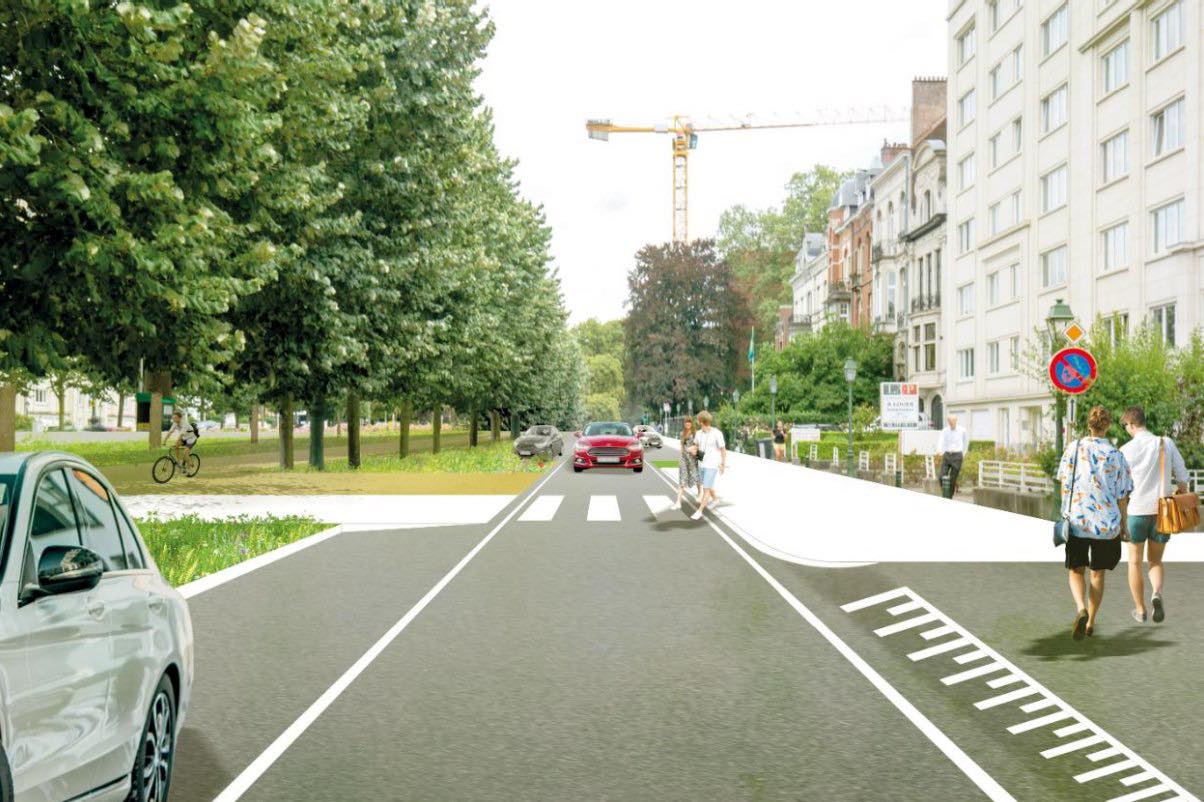The much-anticipated plans for the redevelopment of one of Brussels' key roads, Avenue de Tervueren, have finally been made public after a presentation by the Brussels Government. However the initial proposals have been met with anger from locals.
Sometimes referred to as "the Champs Élysées of Brussels", the large boulevard has two major conflict points: the Mérode and Montgomery roundabouts. These spaces have been designed more with cars in mind than pedestrians and cyclists – something that the redevelopment would change, notably along the busiest section from the Square Léopold II to the entrance to the Parc du Cinquantenaire.

Illustration highlights the main section of the large road that will be redesigned. Credit: Brussels Mobility
Speaking at the unveiling of the plans on Monday, Mobility Minister Elke Van den Brandt outlined the three main objectives: to increase road safety, complete missing links in the cycling network, and improve pedestrian accessibility.
Active mobility
The length that is being redeveloped will feature new unidirectional cycle lanes on both sides of the avenue. The central concourse will still be dedicated to motorised vehicles with two lanes in both directions. Cyclists will be separated from car traffic by trees, of which 117 will be planted.
Municipalities were especially eager that the direction of bicycle lanes remain separate, although several "safe crossings" will make sure that the bike lanes are not impassible highways. As is currently the case, local traffic will be kept separate from the busier central channel with traffic filters to prevent through traffic from driving on these quieter roads.

The roads for local traffic will be located next to the wider pavements and the new one-way bicycle lanes. Credit: Brussels Mobility
At the request of all municipalities affected by the works (Woluwe-St-Pierre, Woluwe-St-Lambert and Etterbeek) 98% of parking spaces will be retained.
Pavements will be 30% wider on the south side of the street and three more pedestrian crossings will be added, fitted with traffic lights.
Tackling problem points
The plan also tackles two major problem points on the Avenue de Tervueren: the Porte de Tervueren roundabout at the Mérode metro stop at Parc du Cinquantenaire and the Montgomery Square.
Porte de Tervueren currently presents a conflict point for pedestrians and cyclists and the roundabout will be replaced by a T-junction regulated by traffic lights, giving more space to every mode of transport.
The bus stop will be moved to speed up transit between buses and the metro (lines 1 and 5). It is hoped this will reduce interference between pedestrians and cyclists though on the south side, pedestrians and cyclists will still share the pathway.

The changes at Merode, where the roundabout will be removed. Credit: Brussels Mobility
At Montgomery – now a hectic and dangerous roundabout – the three lanes for cars in the inner circle will be maintained. A "wide buffer space" will be added between the ring-road cycle path, giving priority to cyclists over drivers.
Traffic flow will be restricted by closing certain entrances and exits and removing the traffic lights. Brussels Mobility has vowed to create 570m² of additional green space, as well as adding rainwater basins to protect against flooding. It hopes that "Montgomery will eventually become the ultimate multimodal hotspot", explaining that the metro and tram station will be completely renovated in a separate project and the bus stations reorganised for maximum traveller convenience.
Related News
- Place Royale: Chaotic roundabout in city centre to become large urban square
- What will Schuman look like after the long-awaited redevelopment?
But although the plans, which have already been modified on several occasions, have been hailed "a gigantic step forward" by the Brussels Government, around 200 local residents who attended the presentation were less receptive, Sudinfo reported.
Many carried placards highlighting their concerns, including how long the work would take. Others criticised the width of the cycle path on the south side of the avenue, saying it would encourage two-wheelers to travel in both directions despite this not being allowed.
A public enquiry will soon be launched; work is scheduled to start in 2025.

